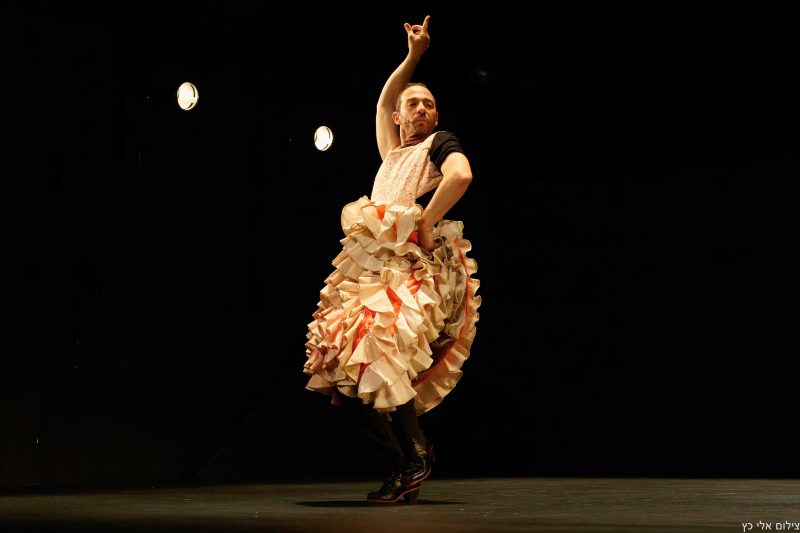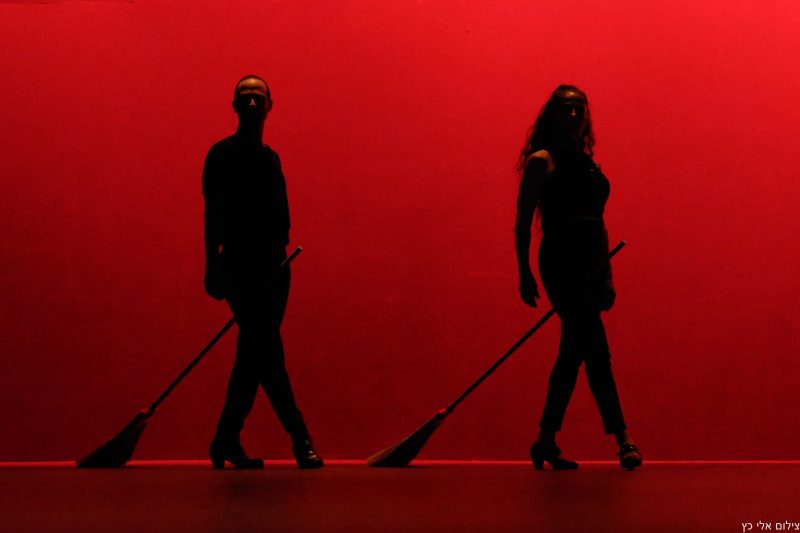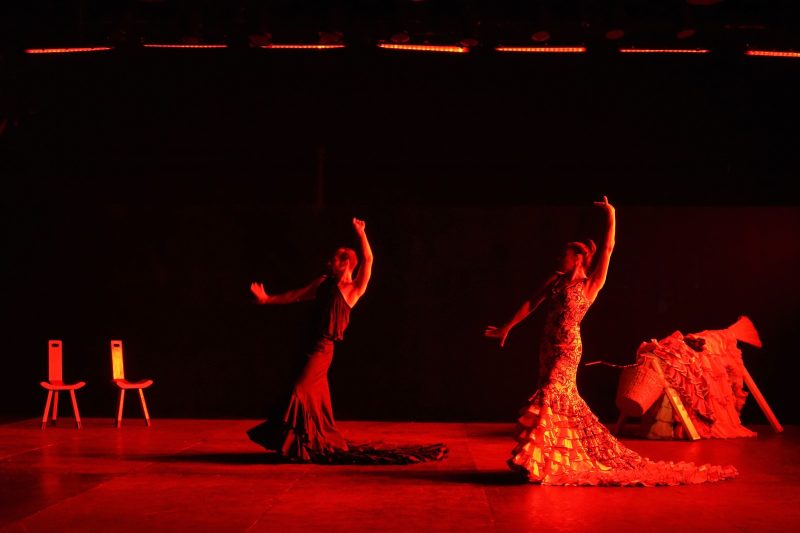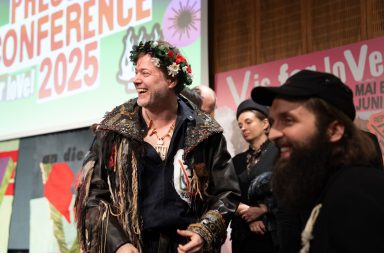Written by Diana Joicaliuc
Israeli choreographer Hillel Kogan presents at the 31st edition of the Sibiu International Theatre Festival, the new show “THISISPAIN” – a journey into the world of flamenco, a pretext to question the concept of national and artistic identity.
Choreographer, dancer, and teacher, Hillel Kogan has collaborated with some of the most important dance companies in the world. He has created works for Muza Dance Company, Shades of Dance Festival, and for the National Ballet of Portugal, and since 2009 he has been part of the Israeli Choreographers’ Association. He is the creator of the multi-awarded show “We love Arabs”, which continues to be presented on stages in New York, Portland, Paris, Munich, Budapest, Prague, and many others. For his choreographies, Kogan received the Teva Award in 2009 and the Yair Shapira Prize in 2010. He is a man and an artist who intrigues, and his revelations about dance and movement are profound. “THISISPAIN” is the show he will present at this year’s festival. What is its story?
I come from the contemporary dance area and knew nothing about flamenco, but I wanted to explore an artistic language different from everything I knew, to create a work in a field that was completely unknown to me. I became interested in flamenco because, on the one hand, it is an art that is strongly identified with Spain, and on the other hand, in Israel there is a great interest in this genre. In the last 30 years, flamenco music and dance have become very popular. Many artists, musicians, dancers, and companies have emerged, so I wondered where this adherence comes from. Why are Israeli artists and audiences so interested in a traditional Spanish art form?
Therefore, I decided to study flamenco. I went to a dance studio in Tel Aviv whose director was Mijal Natan, and I started taking dance lessons with her without telling her that I wanted to create a show. And slowly, after I started studying dance, I realized that I also wanted to learn to sing flamenco music. So, I started taking music lessons as well. I was studying to understand the language and the artistic environment, and until then, I had never imagined that I would dance and sing flamenco in a show. Taking these dance lessons from Mijal Natan, I realized that she was the only dancer I wanted to work with, so I invited her to create this show together. She agreed, and the documentation and creation process lasted about a year.

How is it to have Mijal Natan as a stage partner and how was this encounter between contemporary dance and flamenco?
Hillel Kogan: Mijal Natan is a great artist, very open, passionate about what she does. She is a true professional! She founded this flamenco company in Israel 30 years ago, and as a choreographer, she has created dozens of shows presented on stages worldwide. And I believe it was not easy for her to embark on this adventure with me. Flamenco has a very strict set of rules and codes, and I came with my crazy ideas, a lot of humor, and asked her to sing on stage, to speak, and sometimes to behave like a clown, to laugh at herself and at me, and also to be critical of her own work.
And Mijal is an excellent partner, with a great sense of humor. She is very sensitive, very intelligent. At the same time, she is an amazing ballerina and a perfect flamenco dancer. Let’s not even mention her technique! But she also brings a lot of emotion and is very receptive to new ideas, to experiments. She is the ideal partner! I am already thinking about creating the next show together with her. Mijal Natan is a gift to me.
For you, dance shows also mean a lot of theatricality and a critical eye with which you look at social and cultural norms. What is the relationship between language and movement in your works?
Hillel Kogan: This relationship is what preoccupies me the most in my shows, but I am also interested in issues related to national and artistic identity. In THISISPAIN, I explore the concept of national identity through flamenco. I try to understand why Israeli artists are so interested in making an art that is eminently Spanish, and what it actually means to be Israeli, Spanish, or European.
I am a kind of tourist coming from the contemporary dance area, considered an art form from the realm of high arts, while flamenco is a very identity-bound artistic form. It is the art of the Spanish people, or more precisely, of the Roma, and it has its roots in the street, in the community, in the family. It appeared on stage much later, in the 19th and 20th centuries. Now, even though it enjoys prestige, we perceive it as very different from ballet. While ballet is considered international, universal, and cosmopolitan, flamenco remains a genre connected to Spain’s identity.
This combination of dance and theater in my shows allows me to ask questions in the text, also to use the show as a place for text, and to transform dance into a meeting place between the body, which can be abstract, and the text, which is very direct, very theatrical, and easy to understand. For me, this combination is very interesting because the text provides a filter, offers explanations, or suggests an agenda, and when we stop talking and the dance begins, the audience already has some information. And now they watch the dance through the lens of these details provided in the text. This encounter is sometimes a clash, a conflict, sometimes it is in harmony with the text. And I like this relationship in my shows.

In THISISPAIN, you have a disturbing and ingenious dialogue with Mijal Natan. Through movement or language, you debate, intertwining the verbal with the non-verbal, issues of national and artistic identity, thus questioning the very concept of identity. Dance – art in general – provides a perfect framework for having such difficult conversations. What is the most important message you want to convey through your show?
Hillel Kogan: The most important thing I want to convey is that being on stage, doing ballet or flamenco, being a man or a woman, and all questions related to identity, are nothing but a matter of choice. Identity is not something we are born with, as we tend to believe. I was born Spanish, Roma, Jewish, or Arab. I was born to dance. Being Jewish is in my blood. Or being Arab. Being a ballerina or dancer is in my blood. But what I want to say is that there is nothing in the blood. Blood is just blood, whether we’re talking about a communist, a fascist, an Israeli, or a Spaniard.
This is Judith Butler’s queer theory, according to which identity is a performative act. Beyond any biological act, being a human, a woman, an individual involves a sustained choice, the acquisition of values, the exercise of morals. And that’s why a person has the right to choose whether they want to be a man or a woman.
Now, back to dance, to dance flamenco you don’t have to be Spanish or ask for permission from Spanish authorities. Granted, it is part of tradition, but it is an art form and can be learned. When we say someone was born for flamenco, we refer to the extraordinary talent they have. This means that even a person born in Japan can be very good at flamenco, or a Black African can be skilled at ballet or a traditional Romanian dance.
But all of these are actually our choices of how to behave in a certain way. So, all the identity issues we talk about today, what it means to be Ukrainian, Polish, Jewish, a flamenco dancer or belly dancer, a rapper, or doing Voguing, are matters of interpretation, of how someone chooses to behave. And in this show, we question what it means to be Spanish, even though we are not Spanish. I, Hillel Kogan, allow myself to perform in this show, sometimes as a man, sometimes as a woman, as I please. That’s what I believe is the important debate and message I want to convey through this show.

How important is “Gaga”, the movement language invented by Naharin at Batsheva Dance Company and based on exploring sensations, in your shows?
Hillel Kogan: I think it’s something rather intuitive. I don’t use the Gaga language to create, but it’s something that exists in my practice, in my knowledge base. Gaga is not a style, but a way of thinking about the body, about dance, about movement. So, it interacts with any artistic choice I make because it is related to how I listen to my body. As for my artistic language, I am not that interested in aesthetics or certain codes. I don’t consider that I have a style. In one show, I can dance flamenco, and in another, I can use ballet as a language.
So, I don’t dedicate myself to a single style or language. But, apart from the fact that Gaga addresses both dancers and creators, it also provides a set of tools on how to improvise, how to create, how to combine emotion with technique and virtuosity. And that interests me. What people see at the end of the show is not Gaga, but for me as a dancer, Gaga is a very important part.
What is your relationship with the audience?
Hillel Kogan: The most important thing for me is for people to understand the performance. Of course, I want to offer them entertainment, something pleasant that opens their hearts, something interesting to watch, but at the same time, to provoke questions.
Therefore, the issues I bring up for debate are universal, the concept of identity, what it means to be a woman, European, Jewish, Christian, Romanian. These are questions that concern us all.
I want my audience to enjoy the dance, the virtuosity, and the magic of a show, but besides that, I want them to participate in the debate I propose. I’m not interested in telling people my opinion and convincing them that I am right, but I am concerned with the debate, the dialogue. What is their opinion on these identity-related issues? Do they agree or disagree? I want to stimulate their imagination, not just the spiritual, abstract one that dance provokes, but also the political imagination, to form an idea about this issue of identity.


